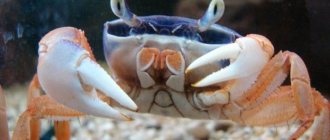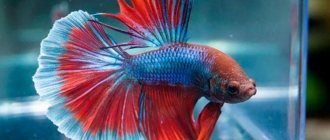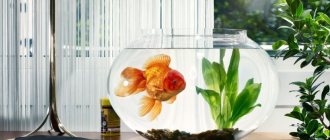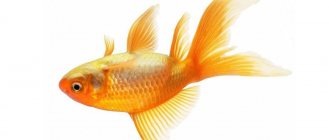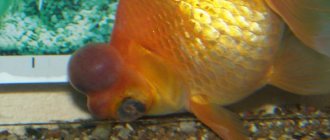Goldfish is the most famous ornamental aquarium fish that is loved by both children and adults. Its ancestors were domesticated in China and Japan back in the 7th century AD. uh, and then they brought it to Europe. The ancestor of all goldfish is the goldfish.
Wild fish usually live in deep freshwater lakes and rivers. The standard color of the scales is reddish-golden. Breeders have developed varieties that differ in body shapes and scale colors. In addition to artificial reservoirs, fish can be found in Central Asia, Japan and European countries.
Care and maintenance of aquarium fish
For a comfortable stay of individuals there are several important rules :
- The presence of a wide and voluminous aquarium. Goldfish are active and need a lot of space.
- Availability of high-quality filter . For large aquariums, purchase a device that pumps up to 200 liters of water per hour.
- The aquarium must have a good nitrogen cycle installed to analyze the nitrate, nitrite and ammonia content in the water.
- The lined gravel should be checked for the content of sharp or metal particles so as not to harm the inhabitants of the aquarium.
- Decorations will decorate the aquarium, but you should also be careful with their choice. We do not recommend decorations with narrow holes in which fish can get stuck.
Basic rules of care:
- The fish is fed 2 times a day with granular or flake food. It is recommended to chop plant foods finely so that the fish can easily swallow them. To improve digestion, experts recommend eating peeled peas.
- Once a week, 20-25% of the water is changed, and the soil is also siphoned with a siphon.
- It is necessary to monitor the condition of the decorations in the aquarium. Decorations or decorations with sharp corners should be removed from the aquarium or the sharp corners should be disposed of.
Caring for your goldfish should include communicating with it. You can make eye contact, and after a while the fish will stop being afraid of the owner and will begin to recognize his hand while feeding.
If a fish falls out of the aquarium, you need to quickly pick it up with your hands soaked in water and return it to the tank. To avoid such cases, it is recommended to cover the aquarium.
Zoological portrait
The aquarium fish we know as goldfish are officially named Carassius auratus auratus (in Latin) and belong to the cyprinidae family. The closest relatives of goldfish in our rivers and lakes are mirror carp, crucian carp, bream, rudd and bleak. But it’s difficult to say which family the Pushkin Golden Fish belonged to, because these fish are predominantly freshwater.
In a home aquarium, goldfish, as a rule, do not grow longer than fifteen centimeters, although they can reach thirty centimeters in length. They have a laterally flattened elongated body of an elliptical shape with a sharp snout (muzzle). The long upper (dorsal) fin begins in the middle of the body, and the short lower (anal) fin is located closer to the tail. The classic coloring of a goldfish is red-gold on the back, yellow-gold on the sides and yellowish on the belly. The fins are painted bright red or any reddish shades, less often they are simply yellow. However, there are specimens of simply exotic colors, ranging from black and blue to white. So the goldfish may not be golden at all, but red, pink, brown or even spotted.
It is possible to determine the gender of a goldfish only in the pre-spawning period. At this time, males, ready for spawning, acquire a distinctive feature - notches located on the front ray of the first pectoral fins and on the gills. A female ready to lay eggs can be easily recognized by her compact, swollen abdomen. If you look at the fish from above during this period, you will notice a curvature of the body, which often remains after the eggs are laid.
An aquarium with goldfish must meet the conditions that are comfortable for them. It is advisable to purchase a special species aquarium with a length of one meter. It is necessary to pour coarse soil onto the bottom of the aquarium and plant a small number of aquatic plants. In accordance with the conditions for keeping goldfish, these should be plants with not very small leaves, such as egg capsule or vallisneria. It is good to place floating plants in the aquarium, which serve as food for goldfish. Of the floating plants, duckweed and riccia are the most suitable.
Comfortable living conditions include water whose temperature ranges from 16 to 24 degrees. Moreover, in winter the water temperature should not exceed 20 degrees, and in summer it should drop below 21. It is necessary to gradually reduce or increase the seasonal water temperature.
Proper care of goldfish also means maintaining a balance of hardness and acidity of the water in the aquarium. Water hardness (dH) for goldfish can range from eight to eighteen units, and acidity (pH) is maintained around seven units. The water in the aquarium, naturally, must be clean and saturated with oxygen, and the height of its layer should not be less than twenty-five centimeters. Caring for goldfish also involves daily water renewal, when one tenth of its total volume is added to the aquarium. It is necessary to add water of the same composition and temperature, and with seasonal temperature changes, increase and decrease the degree using daily water updates. It is also advisable to equip the aquarium with a filter and an aerator.
From the editor: Fluorescent fish GloFish
The maximum permissible number of fish in an aquarium can be determined using a simple formula: for every ten centimeters of fish body length, two hundred square centimeters of water surface is required. For an aquarium without aeration, this norm is doubled. And at the same time, daily water replacement should be at least a third of the total volume. Note that it is much easier to care for fewer fish.
How do goldfish reproduce?
Individuals reach sexual maturity at the age of 1 year , and they can mate as early as 3 years. Spawning most often occurs in the spring season. Characteristic signs: the appearance of a white growth on the body of males (mainly on the gills) and an increase in the size of the female. A sexually mature female produces a special secretion that attracts males. Courtship is manifested in the pursuit of the female throughout the tank. The process itself lasts about 6 hours.
Before breeding, you need to prepare a separate tank for spawning and move a healthy male and two females there.
The volume of the tank should be at least 20-30 liters, the temperature should be from 22 to 24 C° . There is no need to put sand or gravel on the bottom. 24-hour lighting of the tank is important for reproduction. In a spawning aquarium, it is better to maintain the same living conditions as in a regular one.
Emitting lasts gradually: the pursued female lays 10-30 eggs, which the males fertilize, watering them with seed. Up to 3,000 eggs can appear in one spawning.
The eggs attach to plants or the walls of the tank. The fry appear within a week . It is recommended to feed them with special food for fry, which is sold in a pet store.
Feeding goldfish
It is better to feed according to the principle “little and often” . For growth and development, individuals need a balanced diet, so it is recommended to use only natural food. Poor nutrition can shorten the life of a fish. Feeding dry food should be alternated with fresh and frozen. The most convenient option is to eat flake food. There are several types of fish food:
- Fresh vegetables. Fish can sometimes be fed with peas, carrots and spinach, after chopping the vegetables. Vegetables need to be scalded to soften (but not cooked!). You can also give seaweed.
- Frozen food. Can be of animal or plant origin. Purchased at pet stores. Freezing helps rid food of bacteria and preserve beneficial properties for a long period.
- "Live" food. To obtain a sufficient amount of protein, it is recommended that fish be given animal food: earthworms, brine shrimp and daphnia, and sometimes smaller fish.
The fish can be given washed and boiled cereals: buckwheat, wheat or rice. A pinch of food is enough for one individual.
A few important rules for feeding goldfish:
| Moderation | Goldfish tend to be gluttonous, so you need to carefully calculate the amount of food so that the aquarium does not become clogged. |
| Binge eating | Systematic overeating can lead to illness and death of individuals. Veterinarians recommend having a “fasting day” once a month and not feeding the fish. |
| Balanced diet | Some species need carbohydrates rather than proteins; in these cases, special nutrition is required. The food should be rich in vitamins. |
| Aquarium cleaning | Leftover food can rot and poison the water, killing fish, so you must remember to clean the tank on time. |
| Timeliness | Feeding should occur at the same time. This will help avoid overeating, as well as accustom the fish to their owner. |
You can remove leftover food from an aquarium with slow-moving fish species after 10-15 minutes. Individuals need to be fed in a place in the aquarium where there is no vegetation or decorations. Goldfish need to be fed 3 times a day.
Feeding the goldfish
Compatibility with other fish and plants
The aggressiveness of a fish directly depends on its size: the larger it is, the more passive it is towards the rest of the inhabitants of its aquarium. Sometimes fish can hunt for small individuals, eating them. It is prohibited to house goldfish with the following inhabitants:
- guppy;
- swordtails;
- iris;
- catfish and bots;
- labeo;
- barbs;
- astronotus;
- lalius.
It is prohibited to keep fish of different species and families in the same tank if you plan to breed them. It is recommended to plant edible plants in the aquarium, because goldfish tend to be gluttonous.
It is better not to place small objects that an individual can swallow at all. Decorations with sharp edges should be avoided to avoid damaging fish scales. Some species can be kept in undecorated aquariums.
Tips for choosing your first fish
Avoid fish with a specific diet - as a rule, food is the main source of problems in the aquarium. For the first 6-8 months, you need fish that will suffice with regular food - flakes, for example. After six months, the diet can be improved and diversified with as wide a range of foods as possible.
Don't buy too many fish at once. Although an aquarium with several fish does not look very spectacular, try to add fish slowly without risking losing them all at once to disease, for example. A rough rule of thumb is no more than six small fish per week.
Ask the store how long the fish have been kept in the display aquarium. It is better not to take newly added ones, two transplants in a short period of time are too much stress and can lead to problems.
- Find an aquarist you know to give you advice.
- Google about fish before you buy it.
- Don't buy on impulse
- Always know exactly how big your fish grows to
- Write a list of fish you want now and in the future
- Find out the water parameters in your aquarium
- Remember, adult fish can change dramatically
- Avoid deformed and artificially bred fish
- Make sure that the conditions in the aquarium are suitable for your future pets
- Don't buy too many fish
Popular fish such as guppies or neons are actually not the only option for beginners.
In order to choose the right aquarium fish, it is important to understand the difference between one that will take root well in a new aquarium and one that will get sick.
How can you tell a male from a female?
The sex of a fish can be determined by its distinctive characteristics:
- Body. In the female it is predominantly round and slightly swollen, while in the male it is thin and elongated.
- The pectoral fins of males have “notches,” while those of females are short and rounded.
- The male has white growths on his gills that appear only during the spawning period.
- Females tend to behave passively. The behavior of males is more active in the spring.
- The body color of females is brighter, but this sign is also not accurate, since the males of some species have bright scales.
- The anus of females protrudes at the tail and resembles a growth. In males it is elongated.
- In most cases, there is a growth on the male’s abdomen that extends to the anus.
Sexual characteristics begin to appear at the beginning of the first spawning.
Varieties of aquarium goldfish
Individuals are divided into:
- long-bodied;
- short-bodied.
The most popular types of fish:
| View | Description |
| Ordinary | Orange or gold scales; sometimes there is a black-red one with a tint. Small fins on the belly and back, short tail. The length of the fish can reach 30 cm. |
| Comet | The tail is wide and long. Color: red-silver or yellow. The shade “black velvet” is considered the rarest. Length - 20 centimeters. |
| Telescope | Bright or plain scales. The body is short, roundish. The cylindrical eyes are directed to the side or upward. |
| Lionhead | The body is spherical, there are growths on the head. Lumps on the gills can grow and limit vision. There is no fin on the back. White and red scales are the most common color. |
| Tosakin | A wide fan-shaped tail is a distinctive feature of the species. A large body slows down the fish very much. |
| Ranchu | External signs are the same as those of the lion head. A characteristic feature of the species is a crooked spine. Common colors are orange, black and pearlescent. |
| Pearl | Round body, convex plates of scales on the back. The fish reaches 15 cm in length. The most common colors are white and orange. |
| Veiltail | Spherical, sometimes ovoid body. Elongated fins. The tail is long, train-like, forked. |
In total, there are about 300 species of selective goldfish.
Water eyes (bubble eyes)
Bred by the Chinese, it has a short head and a small nose. The round body of the fish can reach 18 cm and has different colors. The most common colors are silver, brown and orange. The main distinguishing feature is large, forward-looking eyes with hypertrophied periocular vesicles. They are filled with water and can make up almost a quarter of the body length. There is no dorsal fin; there is a bifurcation of the caudal and anal fins. The tail blades puff up and do not hang down.
The container is chosen to be 50 liters in size per eyeball, kept under the following conditions:
- water hardness - no more than 20°;
- temperature - 12–28 °C;
- acidity - 6.5–8 pH.
Important! The design of the aquarium where bubble eyes live should be free of driftwood and other decorations with sharp corners, which could damage the bubble around the eye.
It happens that, despite all the precautions, this fish still damages them and they are blown away. With good care, the blisters can recover and inflate again.
With good care, the blisters can recover and inflate again.
Lifespan
The lifespan of goldfish is most dependent on the number of individuals living in one aquarium, as well as on the quality and temperature of the water.
Studies have shown that small fish live up to 5 years, medium ones - from 10 years, and large ones - up to 30. Females die earlier than males.
The record holder for the longest life in an aquarium is a fish that lived for 44 years. The body length of individuals raised in captivity is usually no more than 20 centimeters.
Goldfish are best suited for aquarists and as pets: they are easy to care for, compatible with many other fish species, and easy to breed. An individual may die without regular care, so do not neglect changing water or feeding. Aquarium fish are inexpensive.
Goldfish are sociable: they can take food from hands or swim into an open palm if they trust the owner.
Description
It is an artificially bred freshwater representative of the crucian carp genus. Family – Cyprinidae, Order – Cyprinidae, Class – Ray-finned. The homeland of this representative of the marine world is China.
Appearance
The fish has an elongated body, seemingly compressed on both sides towards the tail. All representatives of the species are distinguished by large gill covers, notches on the ray fins, and, of course, a beautiful large tail. Scales can be of different sizes, depending on the species and size of the individual. The color is rich in various shades of yellow - ranging from light yellow to fiery red. Also, representatives of this species can have pink and black colors. On average, the length of the fish does not exceed 15 centimeters. But there are individuals whose length reached 45 centimeters.
Lifespan
The lifespan of these representatives of the underwater world has a wide range. Several factors influence how long a goldfish lives in an aquarium. One of them is body shape. Fish with a short, rounded body have a long lifespan - they can live from 13 to 15 years. Individuals with a flatter, longer body can live up to 40 years.

